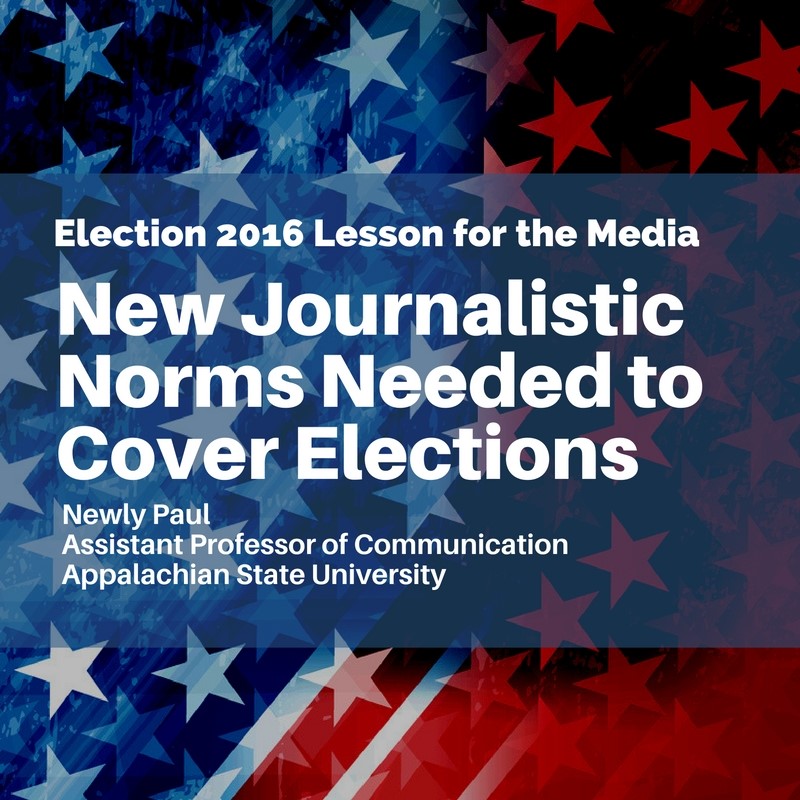
The 2016 U.S. presidential election will stand out in the nation’s collective memory as a highly unusual event for many reasons. It featured two unique candidates, an election campaign that completely overturned the norms set by previous elections, a neglected voter base that showed an unexpectedly strong turnout at the polls, and a national media that missed a huge story.
The media, in particular, have received severe criticism for the role they played in promoting Donald Trump. Faced with a candidate who did not fit the traditional mold of a politician, mainstream media organizations struggled to come up with a plan that would help journalists inform the public while maintaining journalistic standards of accuracy, fairness and balance. Unfortunately, the existing rules of political journalism that favor controversy and poll-centric coverage did not help paint an accurate picture of Trump’s preparedness; instead they helped him win the presidency.
Throughout the campaign, Trump proved to be too much for the media to handle. Right from the primaries season, he made one outrageous comment after another. Given the lack of precedent for inserting commentary into straight news stories, the media simply reported his quotes as facts. Each comment drew enormous amounts of press attention, and when Trump drew criticism for his comments, his campaign issued denials, sparking off another deluge of press coverage. This strategy was hugely successful. During the 2015 campaign season, Trump’s media coverage translated into the equivalent of $55 million worth of ad value for his campaign. In contrast, he spent less than $15 million in ad buys in all media throughout 2015.
Another factor that favored Trump’s campaign was the media’s propensity to cover elections using horserace and game frames. Stories using these frames focus on candidates’ poll numbers and have little accompanying commentary. They are popular because they are less expensive and easier to produce than investigative or long form journalism pieces, but their inclusion comes at the expense of stories focusing on candidates’ issue positions. Given the media’s preference for horserace coverage and with Trump winning primaries and surging ahead in the polls, the resulting media coverage focused almost entirely on Trump and was either positive or neutral in tone throughout 2015. Between June and December of last year, Trump received 34 percent of media coverage, while all other GOP candidates received half this amount or lesser coverage.
After Trump won the Republican nomination in the summer of 2016, several media organizations began looking into his personal and business affairs in greater depth. The result was a series of articles on his failed business ventures, fraud allegations, racism, and his appalling attitude towards women. However, fearing they would be perceived as partisan and biased, the media tried to create a balance in coverage by publishing equal amounts of criticism on the Democratic nominee Hillary Clinton. They focused on one particular flaw—her use of a private email server during her time as secretary of state. The result was a flood of media coverage on this issue, which created a false equivalency between the two candidates and portrayed them as equals, though they differed vastly in terms of temperament and experience.
Looking back at the media’s role in the election year, critics have made several suggestions to improve political reporting. First, given the unconventional nature of the Trump candidacy, the media should invest heavily in fact checking and run these as part of daily news coverage on the White House. Second, newspapers should make a consistent effort to include diversity of race, gender, and class in their newsrooms. This will help counter the “coastal bias,” which was a huge factor in causing the media to miss the surge among white working class Trump supporters. Finally, the media should gear up to report on what the president is actually trying to do, rather than focus on his populist tweets, and rally together to resist efforts to delegitimize the press.
About the Author: Newly Paul is Assistant Professor of Communication at Appalachian State University. Her research focuses on political advertising, political communication, and race and gender in politics. Her website is newlypaul.weebly.com.
